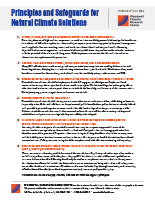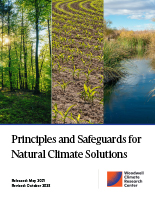Enhance human welfare and “do no harm.”
Prepared by Glenn Bush and Richard Birdsey
Summary
Natural climate solutions should aim to generate a net enhancement to human welfare, while doing no harm to impacted parties. If the tradeoffs between the private and public benefits from policy choices are clearly defined and quantified, potential negative outcomes can be identified and mitigated to the greatest extent possible. Unless natural climate solutions can be demonstrated to have clear overall benefits to society and impacted stakeholders, and private costs mitigated, they are unlikely to be adopted.
Impacts and benefits of natural climate solutions
Natural climate solutions (NCS) involve land and aquatic ecosystems that provide a wide array of services to society, in addition to carbon sequestration, such as providing timber products, maintaining biodiversity, protecting endangered species, sustaining food supply, providing water and erosion control, and maintaining soil productivity (Millennium Ecosystem Assessment 2005). Although these services may be altered to reduce carbon emissions, increase carbon sinks, reduce risk or adapt to climate change, it is highly desirable to avoid reducing the capacity of land and water to sustain life on earth.
Several recent studies of NCS have considered the impact on ecosystem services. The U.S. National Academy of Sciences consensus study report on negative emission technologies (NAS 2018) focused on assessment of the potential of different technologies and research needs that would be necessary to reach net zero emissions by 2050 while avoiding harm to the world’s food supply or biodiversity. It was found that competition for land limits the expansion of some terrestrial-based negative emissions strategies, and that a significant investment in research is needed to reduce their negative impacts and costs. A comprehensive global analysis of NCS by Griscom et al. (2017) imposed constraints to safeguard the production of food and fiber and habitat for biological diversity, and found that they also can offer co-benefits such as water filtration, flood buffering, soil health, biodiversity habitat, and enhanced climate resilience. Similarly for the US, Fargione et al. (2018) estimated the potential of NCS after imposing constraints to safeguard food and fiber production, and highlighted potential co-benefits.
Environmental valuation; an operational framework for measuring social performance
Do no harm is an objective to be assessed through environmental cost benefit analysis. Where adverse effects to a specific group can be predicted, a NCS scheme could still go ahead if the net benefits to society are clear. Implementing NCS requires systematic changes to land use involving multiple entities: private landholders, communities, local and national governments, and Indigenous Peoples (Principle #3). NCS also involves complex institutions; policies, laws, customs and cultural preferences; technical solutions governing land use outcomes inevitably lead to trade-offs (losses and gains between actors) from selected courses of action. Applying an ecosystem services approach to explicitly value links between environmental and social impacts can help to objectively identify effective policy mechanisms (taxes/subsidies, voluntary agreements or regulations) to manage outcomes (USDA 1998). Ecosystem services are public benefits, largely provided at no private cost, meaning they go unvalued and therefore unpriced in consumer markets, until such time as their decline in quality begins to critically impact on human wellbeing (a market externality).
Environmental and social impact assessment; an existing institutional arrangement for performance appraisal in the USA and beyond
Globally, environmental impacts assessment (EIA) is well established as a best practice for economic development projects in the public and private domain (Eccelston, 2011). The United States National Environmental Policy Act of 1969 (NEPA) established a policy of environmental assessment (EA) for federal agency actions, federally funded activities or federally permitted/licensed activities. Specifically, within the broad EIA framework, social impact assessment enables the qualitative and quantitative appreciation of the social and financial costs and benefits of proposed NCS measures. Globally, there is general consensus that EIA can play an instrumental role in fostering sustainable development (Del Campo et al., 2020). EIA for projects and its policy program equivalent, strategic environmental assessment (SEA) can support the delivery of the UN-Sustainable Development Goals (to which the US is a signatory) by integrating the relevant considerations pertaining to the goals through setting up, clarifying, or enhancing SDG-relevant targets to be achieved as part of development plans/programs.
There is strong international consensus on best practices in social impact assessment (SIA) (Esteves et al. 2012). This consensus requires a comprehensive inventory of directly and indirectly affected communities and activities, and an assessment of the economic costs and benefits from the proposed changes; the objective being to estimate the net benefits and distributional impacts between involved parties from potential landscape outcomes. In the United States, the 2003 version of “Principles and Guidelines for Social Impact Assessment” (Burge et al. 2003) provides guidance for the conduct of SIA within the context of the U.S. National Environmental Policy Act of 1970. Guidelines are integrated within six principles focusing on: 1) understanding of local and regional settings; 2) dealing with the key elements of the human environment; 3) using appropriate methods and assumptions; 4) providing quality information for decision making; 5) ensuring that environmental justice issues are addressed; and 6) establishing mechanisms for evaluation/monitoring and mitigation.
By valuing ecosystem services in addition to private financial losses and gains from NCS adoption, implementing agencies can make decisions that may strengthen both a project’s performance, and community and social resilience. Systematically evaluating ecosystem services in the EIA/SEA process will help implementing agencies understand how a project may affect priority ecosystem services, as well as how the project’s performance or success may depend on certain ecosystem services. By better understanding project impacts and dependence, implementing agencies can better identify and manage a project’s environmental and social risk which may also be critical barriers to uptake of NCS. Valuation can enhance the EIA/SEA process by providing decision makers with a quantitative equivalency framework for comparing the disparate potential effects of a proposed action.
Total economic valuation; a well-established tool to examine the public and private trade-offs in NCS adoption
Through total environmental valuation (TEV), the net welfare impacts from adopting NCS can be estimated for a broad range of goods and services. Values can be imputed for a specified time frame under “business as usual” conditions and compared to those gained from alternative NCS implementation through a process of environmental cost benefit analysis (Hanley and Barbier 2009; U.S. EPA 2010). For example, the benefits of forest resources have historically been valued in terms of their direct benefits such as jobs in the economy, timber harvesting, tourism and other non-timber forest products. However, there are also a multitude of indirect benefits and costs. It is the sum of all these values that accrue at local, regional, and national levels that generates the total economic value of an NCS strategy in a given location (Ashford 2012). Increasingly in the U.S. and internationally, there are a growing number of voluntary social standards frameworks governing best practices for private sector financial performance, business practices and international development programs incorporating the principle of “do no harm.” In the private sector, these are framed as environmental and social governance standards1 and business practices2. In international development circles, there are examples of the International Finance Corporation social standards framework3, and the 2030 UN sustainable development agenda4. The TEV framework can be directly applied to measurement of performance against such standards.
The TEV concept is well established as an analytical framework (Turner 1993). Since the publication of the Millennium Ecosystem Assessment (MEA) (Overpeck et al. 2013), there has been renewed interest in ecosystem services valuation, which provides a broader temporal and spatial framework to understand the human welfare benefits generated from biodiversity and ecosystem goods and services (Groot et al. 2011) e.g. pollination services from insects, wild food, climate regulation and cultural values. In addition, the ecosystem services approach (Groot et al. 2011) also identifies the property rights and institutional arrangements governing the system. The combined result is a biologically, socially, and economically integrated framework to understand externalities in policy and management of natural capital. The MEA aggregates the different economic benefits from biodiversity and ecosystems under categories of different socio-ecological functional roles (provisioning, regulating, cultural and supporting). The socio-ecological categories then correspond directly to different economic categories of benefits (Table 1).






